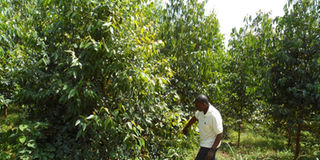A way of growing trees and other crops on dry soils

With the use of hydrogels, even trees like eucalyptus can thrive in areas where the soil may not ordinarily support such plants which require a significant amount of rain and nutrients. File Photo.
What you need to know:
Dry lands have soils that have less nutrients and receive little rainfall. Scientists have found a way to enable growth of trees and other perennial crops with these conditions.
It is possible to grow tree species in dry lands, which would not ordinarily be found in such places that characteristically have less soil nutrients and water. This is through a technique developed by Ugandan scientists to sustain water in the soil.
Researchers at Makerere University’s College of Agriculture and Environmental Sciences (CAES) have developed a technology from an experiment using organic powder called hydrogels, which absorbs water in sandy soils to keep the dry soil wet for a plant’s survival for a longer period of time.
They are manufactured substances that absorb water and hold it in the form of a gel. So, by application of hydrogels, farmers are able to cultivate perennial crops most especially tree species in dry lands.
Plant survival
At Makerere, the experiment that led to the development of the technique started as a project, where the researchers tested the seedlings of different tree species in potted sand. They then amended the process with specific measurements of hydrogels to monitor the performance after watering for a period of eight weeks.
Vianny Ahimbisibwe a researcher at CAES’ department of forestry, says the study was done to address the challenges faced by farmers who grow especially in water-stressed land or want to grow trees in similar areas.
“We first asked the question as to why certain desert countries are big producers of crops and we realised that it was as a result of using hydrogels to contain water in the soil, which can be applied by our farmers here,” he said. Their use of super absorbent hydrogels is the prolonging of plant survival under water-stress conditions.
So, the study undertaken by the Makerere team of scientists examined the roots and shoots of the seedlings of nine species, which included Eucalyptus grandis, Terminalia superba and Pinus caribaea.
The seedlings were potted in these soil types: Sand, sandy loam, silt loam and clay. They were amended at two hydrogel levels—0.2 and 0.4—and grown under controlled conditions in a greenhouse. They were watered and later subjected to water stress by suspending the watering at the end of eight weeks. This was to see how the seedlings would grow and the result showed that the trees would grow well under this water-stressed conditions.
Therefore, the scientists came to a conclusion that farmers in Uganda, who are living in semi-arid and drought-prone areas where average precipitation is significantly less, can grow perennial crops by amending the soil with hydrogels. Ahimbisibwe encourages farmers to adopt this method so as to grow trees and other perennial plants in dry areas.
Adopt the method
After applying the hydrogel to either the soil put in plastic bags or in the hole, with the little amount of rainfall, it will keep the soil wet for the trees to grow.
Ahimbisibwe points out that most farmers in Uganda who are currently engaged in using this technique are in large-scale commercial agriculture like sugarcane growing or forestry. Hydrogels can be obtained by farmers from companies that sell agro-chemicals throughout the country as well as at Makerere where this study was undertaken.




